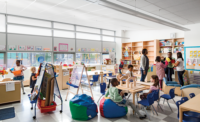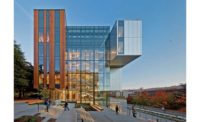Green Project Best Project - Community Arts and Sciences Building, Common Ground School

PHOTO BY DAVID SUNDBERG, ESTO PHOTOGRAPHICS, COURTESY BENSONWOOD

PHOTO BY DAVID SUNDBERG, ESTO PHOTOGRAPHICS, COURTESY BENSONWOOD

PHOTO BY DAVID SUNDBERG, ESTO PHOTOGRAPHICS, COURTESY BENSONWOOD



Community Arts and Sciences Building, Common Ground School
New Haven
Best Project
Owner Common Ground School
Lead Design Firm Gray Organschi Architecture
General Contractor Newfield Construction
Environmental Engineer Atelier 10
Structural Engineer Bensonwood
MEP Engineer Altieri, Sebor and Wieber
Design/Build firm, Fabricator and Builder Bensonwood
Cross and Glue-Laminated Timber Production Nordic Structures
The $9.6-million Common Ground School’s Community Arts and Science Building is not just an educational facility, it’s also a teaching tool. The 13,000-sq-ft mass timber structure for the New Haven charter school is a beacon for green building that combines ecology and building technology in a way that is accessible and teachable for students and teachers alike. In fact, the school, which has an urban agricultural and sustainable land management curriculum, also has a sustainable design class about how the school was built.
One of the first buildings in the country to use cross-laminated timber (CLT) as its primary structure, the school, which is likely to obtain LEED Gold status, uses black spruce CLT panels for the tension surface and final ceiling finish, as well as for an innovative panelized roof system.
The carbon sequestered in the building’s structural system offsets the annual emissions of 77 cars, making the building carbon neutral in its first decade of operation. Other sustainable features include onsite energy production, stormwater treatment systems, natural illumination and passive ventilation.
The school includes nearly 15,000 sq ft of science and art classrooms, administrative office space and multipurpose community space in a high-performance, energy-optimizing building.
Fabricating the CLT panels off site under controlled conditions allowed for rapid onsite assembly. The project was delivered in approximately one year with no lost-time accidents. This speed was apparent in the installation of the 495 CLT panels providing the roof sheathing, with crews requiring just 59 crane picks to assemble the 4-ft by 8-ft sheets that make up the roof. The team’s Best Projects entry noted that working at this pace significantly reduced the amount of time required for crews to be exposed to potential fall hazards while working at elevation.
The prefabricated system also included stressed skin assemblies that span the upper classrooms and circulation spaces. Vertical CLT panels make up bearing and shear walls throughout the building, while glue-laminated rafters and heavy timber trusses span its large ground floor multipurpose space.
Chris Carbone, engineering steward at Bensonwood, said, “The CLTs are used as the bottom flange of an insulated box beam that allow for 33-foot spans. The roof panels themselves are 17 inches thick and rated for R-55 performance.”
Alan Organschi, of Gray Organschi Architecture, said the client challenged the design team to create a building that is healthy for both the school community and the environment. He also said the new building “offered our design team the rare opportunity to work closely with dedicated teachers and deeply engaged students to craft a special architectural design.”







